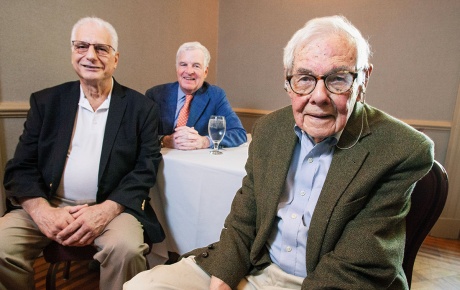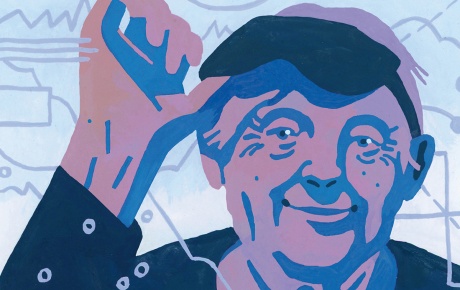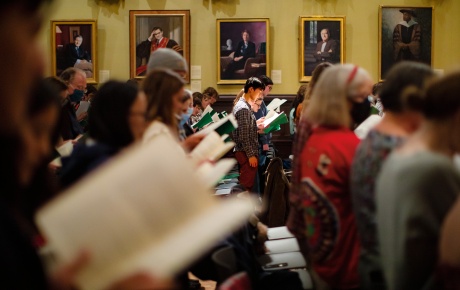Sports
Pigskin Prospects
The football team's got the first wide receiver ever to be named Ivy League Player of the Year. But is it enough?
THE STAR
Ever since New York Herald Tribune sportswriter Caswell Adams first coined the term Ivy League in the 1930s, Brown and its seven rivals have looked on while large state schools across the country built up industrial-sized football fac-tories. Without athletic scholarships to dole out, the Ivies just couldn't compete. By the 1950s, colleges like Michigan and Penn State were cranking out bigger, faster, and more highly skilled football players at every position - except one. Wide receivers remain the Ivy League's stock in trade. Some sport historians believe that all-time greats such as Dartmouth's Dave Shula, Princeton's Derek Graham, and the Bears' own John Parry '65 and Bob Farnham '77 could have held their own in any conference. Oddly enough, though, no receiver was named the Ivy League's top player until last year, when Brown's Sean Morey '99 began erasing and re-inking the Ivy record book, line by line.
During a brilliant 1997 season, Morey became the first player in Brown football history to be named Ivy Player of the Year. He was only the third player in the league's history to receive the honor while a junior. His total of 1,434 receiving yards last fall was the sixth best in NCAA Division I-AA history and the best performance by a wide receiver in the 1990s.
Morey runs counter to the current NFL trend toward big, powerful receivers. In fact, he was so skinny during his spotty, injury-plagued high school career at Hebron Academy in Hebron, Maine, that his teammates labeled him Bone Rack. But while his current five-foot-eleven-inch, 190-pound frame is still comparatively slight, Morey ranks fifth in the country in receptions per game (7.3) and leads Division I-AA with 142.7 receiving yards per game. And all this from a guy with another season yet to play.
Is Sean Morey the best Ivy receiver ever? According to Carm Cozza, Yale football's head coach for thirty-two years before his retirement in 1996, Morey comes close. "We wanted him very much," says Cozza. "In fact, I took our offensive coach, and we drove all the way up to Hebron Academy to talk to him." Phil Estes, Brown's new head coach, was an assistant to then-head coach Mark Whipple '79 when Morey showed up on campus. "What I first noticed about Sean," he remembers, "was his unusual intensity and love of the game. We almost had to throw him out of the office. He was always afraid he had missed something. He wanted to see more tape [of receivers] and borrow more books. He wanted to watch pro tape."
James Perry '00, one of two superb quarterbacks whose strong and accurate tosses have allowed Morey to explore the outer limits of his ability (the other was Jason McCullough '97), notes that his receiver is always thinking football. "Sean's always looking for weaknesses in defensive backs. Watching films of opposing teams, he might notice that the left cornerback has a tendency to get beat deep. Then he has the speed and determination to take advantage of that."
Complementing these gridiron smarts, Perry adds, are Morey's physical gifts. "He's clearly the quickest receiver I've ever thrown to," he says. "You can loft a pass that would be out of reach of most guys and he's able to haul it in. On top of that, he's amazingly sure-handed and runs crisp routes with hard cuts and direction changes."
Morey, who hails from Marshfield, Massachusetts, comes from a tight-knit family that includes two brothers and a twin sister. He attributes his ability to screen out distractions to his father, Dennis, a commercial shell fisherman. "There are a lot of people who praise you," says Sean. "And there are a lot of critics out there. I try not to get too high or too low. I get that from my dad, who played semipro ball. We've always talked about what football means. It's the offensive line. It's the quarterback. It's the defensive backs I practice with. It's not about me."
Few people know Morey as well as Estes, who worked closely with him last fall, when Estes was the receivers' coach. "My thing with Sean," Estes says, "has always been to try and take him to another level. It's always dangling that golden carrot a little higher. At first, this would sometimes frustrate him. Then he started to thrive on it. I would tell him he'd made a pretty good play and he'd say, 'No, Coach, I should have done such and such.' "
"One thing I've learned from Coach Estes is that as a team you can accomplish so much more than you can as an individual," says Morey, who along with cornerback Alex Pittz '99 is the team's 1998 co-captain. "I used to think, well, I can score a touchdown. Now I realize that's still not enough."
THE TEAM
Coming off a 7-3 (4-3 Ivy) season, the Bears will need more than the heroics of Morey and quarterback Perry - the first sophomore ever named to the All-Ivy team - to make a serious run at the Ivy title. Rounding out the offense are receiver Steve Campbell '00, who last year totaled 405 yards in thirty-five receptions, and fullback Mike Wall '99, whom Estes calls "one of the strongest guys on the team and one of the hardest-working."
The defense is a bit threadbare. Estes hopes for crack performances from cornerbacks Pittz ("a good one-on-one guy") and Matt Swistak '00 ("a hitter with excellent speed"). Helping shore up the defensive line will be Fry Wernick '99 and Pete Huntington '00, a big bruiser who transferred to Brown when Boston University disbanded its football program last year.
And then there's Azibo Smith '00, who, like the Brown Iron Men of the 1920s, will play tailback on offense and strong safety on the other side of the ball. According to Estes, when Sean Morey found out about this arrangement, he was envious. "As if being the league's top receiver isn't enough," says Estes, "he wants to play defense, too."
Women Capture the Henley
The choppy currents of England's Thames River brought international fame to women's varsity crew this summer - just as they did to the men's varsity boat five years ago. The women's varsity eight won the premier event at the Royal Henley Women's Regatta by beating the Imperial College Queens Tower by three lengths in a time of 4:55 over 1,500 meters. It was the finishing touch to a stellar season that saw the boat go undefeated except for a second-place showing at the NCAAs.
The cup-capturing crew consisted of Kate Saul '00, coxswain; Caroline Grogan '00, stroke; Catherine Humblet '98, seven; Margaret Gardel '98, six; Ginger Dewing '98, five; Helen Betancourt '98, four; Leslie Garrett '98, three; Nina Carter '00, two; and Emily Zobel '00, bow.




